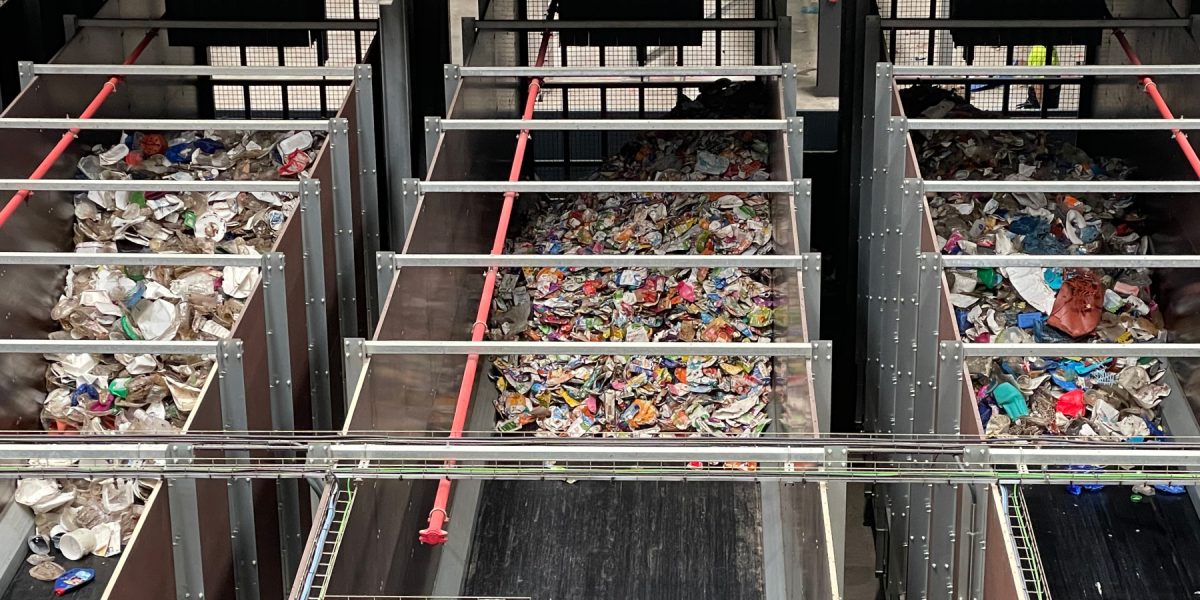The Journey of Recycling
On-Site Sorting
Recycling begins with proper sorting at the point an item is discarded. Whether in your business, at home, or in a public place, the first step to effective recycling is sorting at the point of collection. This means throwing your recyclables into the correctly designated bin.
For a Business:
Having an effectively designed bin system is essential for reducing contamination and setting your business up for success.
Place bins in highly trafficked areas that are easily visible and accessible. Clearly, visible waste receptacles improve proper waste disposal.
Ensure enough bins are placed at constant distances around premises. Bin users are unlikely to travel further than necessary to dispose of their waste.
Ensure a full range of recycling bin options (and other waste receptacles) are placed next to each other. Research has shown people are likely to use the most available bin option and will not travel to find the correct waste receptacle if they are separated.
Use clear signage and provide guidance on which bin is designated for which waste stream. Use images, icons, infographics, and ensure your language is clear and understandable (use multilingual signage as appropriate for your community).

Collection
There may be multiple points of collection depending on your system. After items are initially discarded by the user, they may be collected into larger bins either within your business or residentially in a building, before ending up in the final collection bin from which they are picked up by a waste hauler. Each stage of collection provides the opportunity for improper sorting and contamination of waste streams.
Recycling is collected from your business or home by your waste hauler. Waste haulers are contracted either for commercial service by your business (or building) or for residential / municipal service by the local government to collect and transfer waste to proper treatment facilities.
Treatment
Single-Stream Recycling
Most often, if your recycling is collected as “single-stream recycling” such that all materials are mixed together, the next destination in its journey is a “Material Recovery Facility (MRF)”, which is a large facility designed to sort different material streams through mechanical processes. MRFs separate and prepare single-stream recycling materials to be sold to end buyers (Rubicon). At an MRF, cardboard could be baled, aluminum could be crushed and baled, glass could be crushed and separated by color. For each of these materials, an end-buyer has specific needs and expectations. For example, glass can only be recycled if all of one color is collected together, and clear glass is highly favored over colored glass. Multi-colored glass is less desirable because it is difficult to sell products made from multi-colored glass.
The two primary types of MRFs are “clean” or “dirty”. Clean MRFs only accept recyclables that have been collected separately from general trash. Dirty MRFs accept all waste streams intermingled and sort out recyclables. Ask your waste hauler (or research your municipality) to confirm how waste is collected and sorted to make sure you have the proper bin designations in your business or home to ensure your items are recycled by supporting the waste management system in place.
The benefits of a single-stream system include cost savings on collection costs as there is a one-bin system and no sorting required upstream, which also makes it easier for all to participate (Nat Geo). However, it costs an average of $3/ton more to maintain overall than dual-stream systems that separately collect paper from other materials because glass and plastic shards, chemicals and food grease contaminate paper and threaten recyclability.

Multi-Stream Recycling
If your recycling is collected as “multi-stream recycling” this means that you separate recyclables into two or more different waste streams separate from general trash, such as paper / cardboard, glass / aluminum, and plastic. This separation needs to be maintained by users until collection by your hauler. At this point, because waste is “pre-sorted”, your hauler may take material directly to facilities that can process that material into new feedstock or products, such as a paper mill, scrap metal center, or glass recycling facility. It is possible your waste hauler would still take collected material to an MRF.
Landfill / Incineration
In the worst case, your hauler might collect all waste streams intermingled into the same truck and not separate or sort out recyclables. This sends your carefully sorted recyclables to the nearest landfill or incinerator.
Your recyclables could also end up in a landfill or incinerator if a recycling facility is at capacity and is forced to turn away any further material.
Call-To-Action: Ask your waste hauler directly where your recycling is going!
